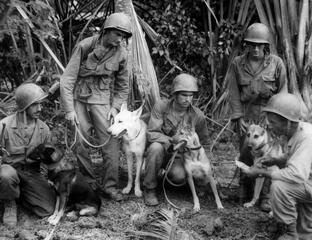|
By Dick Martin  Now that horses have had their time in the sun as great contributors to the war effort during WWII, it is the dogs’ turn in the limelight as great military contributors. I have always said that dogs are God’s second greatest invention, grandchildren being His greatest. Soldiers would probably agree that dogs provide more than companionship, and there are many stories, especially coming out of the mid-east wars, of handlers being so attached to their dogs that they petitioned to take them home with them as pets. During WWII, nearly 20,000 US families donated their canine pets for military service through the Dogs for Defense program. Because of the demands of the war and due to deployments, many were no longer able to properly care for their pets. Initially the dogs were recruited and trained to patrol Atlantic Beaches, key industrial facilities and other places ripe for saboteurs. By July of 1942, the first hundred canine “volunteers” had proven their utility as sentries allowing them to expand their missions to scouts and messengers. Trained by the Quartermaster Corps, an army canine training manual was written in 1942 to facilitate the training of dogs. Some of the important names in the training of dogs for warfare were Ray Nosaka, Robert Coates, Len Brumby, Arthur Kilbon, William Prestre, and John Pearce. The handlers with their dogs-in-hand began their training at noon each day at Cat Island near Gulfport, Mississippi, learning to find the Japanese in fox holes and trees, alerting their handlers to the presence of enemy soldiers and attacking only when commanded. It seemed that the dogs worked better in packs than alone. The entire program had dismal results in accomplishing its goals. Consequently, after an Army review, the entire project was canceled. In the spring of 1943 with the army reinstating the program, the Quartermaster Corp took over management of the program. From experience, the Army, by 1944, had fine-tuned the list of most useful breeds to be German Shepherds, Doberman Pinscher, Belgian Sheepdogs, Collies, Giant Schnauzers, Siberian Huskies, Malamutes, and Eskimos dogs. They were trained to deliver messages and notes. Any dog that did not perform was dismissed from the program. From 1942 through 1945, nineteen thousand dogs were recruited, ten thousand four hundred of which completed training successfully. After all the training in warfare activities, the canine's most valuable contribution likely has been companionship. Taken mostly from an article “Dog Bait on Cat Island” by Jessica Wambach Brown found in the Spring of 2023 issue of World War II magazine.
0 Comments
Leave a Reply. |
Categories
All
Archives
October 2023
|